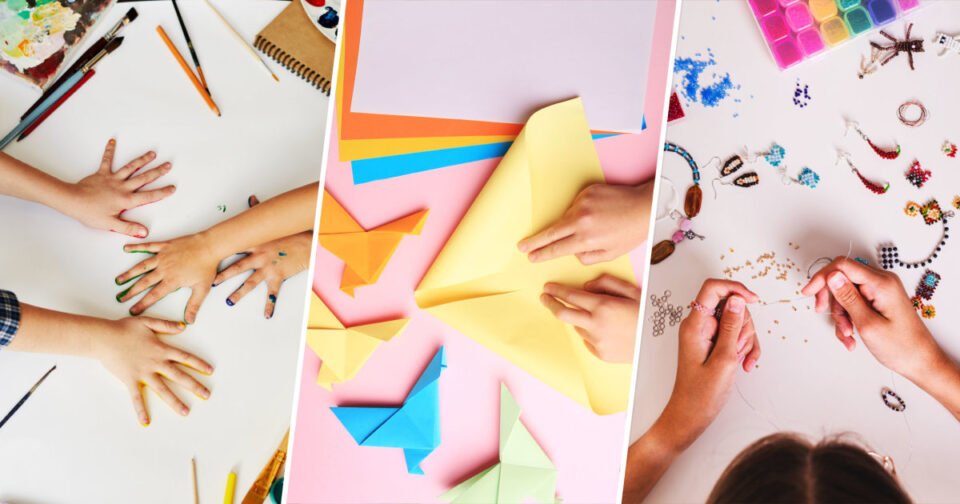Crafts for kids don’t have to be complex. Using your child’s senses, imagination and problem-solving skills, you can use these crafting projects to fight boredom blues at any age.
Kimberly McLeod, a kids’ craft expert and the creator of the popular kids’ craft and activity website, The Best Ideas for Kids, helped TODAY.com compile a list of arts and crafts ideas for every child of any developmental age, courtesy of
Crafts for Babies (0-2 Years)
Focusing on sensory and fine motor skills is paramount for crafts geared toward babies.
Playdough, bubble wrap or finger paints are the best tools for these activities. Simple paper plate crafts and crayon drawing are great activities for 2-year-olds. Prioritize safety by using non-toxic and age-appropriate materials.
“With simple supplies, you can create many different things,” says Kimberly McLeod of The Best Ideas for Kids. “One mess-free way for toddlers to paint is by putting paints and paper inside a ziplock bag and having them smush it around,” she said. Other ideas include:
Sponge Painting: Cut sponges into different shapes. Brush the sponges with paint, and then toddlers can stamp on paper.
Footprint Art: Getting handprints can be difficult for children this age. Try making a footprint for a keepsake craft instead! For an easier cleanup, keep some baby wipes nearby so they can easily wipe their feet and hands when the work of art is complete.
Sensory bag: Sensory bags expose young toddlers to various shapes, colors, and textures, keeping all the items in one place.
Crafts for Preschoolers (3-5 Years)
For 3- to 5-year-olds, simple, open-ended crafts encourage creativity and development of fine motor skills.
A few ideas include paper plate crafts, finger painting, playdough creations and collages using leaves or fabric scraps. Children can explore textures, colors and shapes using paintbrushes, craft paper, stickers, sponges and more while developing their hand-eye coordination, problem-solving skills and ability to follow instructions.
“The best part about following a step-by-step craft is that kids can learn how to follow steps, but that doesn’t mean they have to be limited in their creativity,” says McCloud.“For example, when my daughter first made this frog, she decided her frog was going to be purple. She wanted to make the eyes different.”
More preschool ideas:
Fingerprint Art: Preschoolers can use their fingerprints to create art! Try making a caterpillar, a rainbow, or flowers.
Cotton Swab Painting: Use a cotton swab to practice fine motor skills. Have the children dot inside a printable template to create a unique piece of dotted art.
Tape-Resist Painting: Use painter’s or washi tape to create tape-resist painting. Kids can paint inside the shapes (for example, creating geometric patterns), then gently remove the tape after the paint dries.
Crayon Resist Art: Use a white or black crayon to create wax resist art. Then, the kids can paint on top using watercolors.
Paper Plate Snail: A simple and easy paper plate creation using fabric, paper, and other household items
Crafts for young elementary school students (6-9 years)
Some crafts for children ages 6 to 9 include DIY lanterns, paper plate animals, beaded butterflies, bubble painting and leaf stamping. These activities are generally accessible and engaging for this age group. Paper flowers, paper chain snakes, paper baskets and paper plate snakes are also options.
More early elementary ideas:
Nature Art: Get kids involved and inspired by creativity in the outdoors. You can get started making art in nature with a project like leaf painting: Find leaves and paint the vein part of the leaf with acrylic paint or watercolors. Then stamp on paper.
Craft Stick Coaster: Glue craft sticks together to make your coaster. Kids can draw or paint on their coaster when they are done.
Puffy Paint: To make puffy paint, mix equal parts glue with shaving cream and color with food coloring. Kids can then paint with the puffy paint, which will dry with a 3D effect.
Crafts for tweens and teens (10+ years)
With older kids, you can get crafty. Teenagers and tweens should be encouraged to step away from screens and engage in creative pursuits.
More tween ideas:
Make Salt Dough: Salt dough is straightforward to make. You just need flour, water, and salt. Once you’ve made the dough, you can roll it out and use cookie cutters to create your ornaments or magnets. Let them air dry and then paint them. Note: Keep salt dough out of reach of pets.
Salt Painting: Salt painting is a fun sensory art activity for tweens. Have them create an image with flowers, rainbows, or even their name using glue. Shake salt onto the glue and then shake off any excess. Then, use watercolors to “paint” the salt. It’s like magic to see the paint run along the salt.
Craft Stick Bird Feeder: Use craft sticks to make your bird feeder. First, glue the sticks together to create the base, and then glue more sticks around the edge to make a border. Once you’re happy with the height, add some string to hang it.
Geometric Art: Create unique geometric art by adding lines inside a shape (like a heart, butterfly, or leaf) Then use watercolors to paint inside these lines.
When children discover art through crafting, they develop essential skills like creativity, problem-solving and fine motor coordination. Art also fosters emotional expression and enhances cognitive development. Their artistic endeavors can evolve as they grow to help refine their critical thinking and communication skills.

